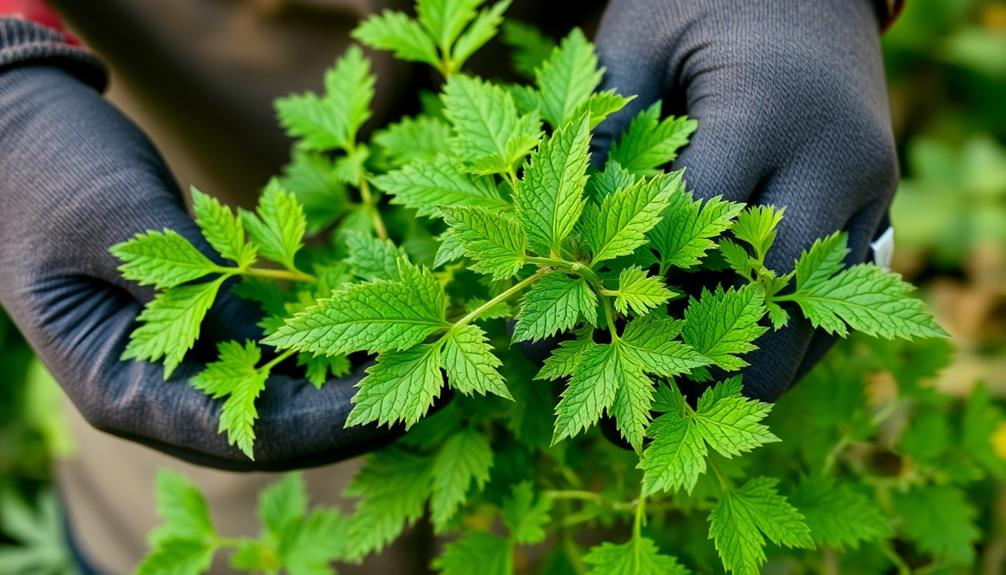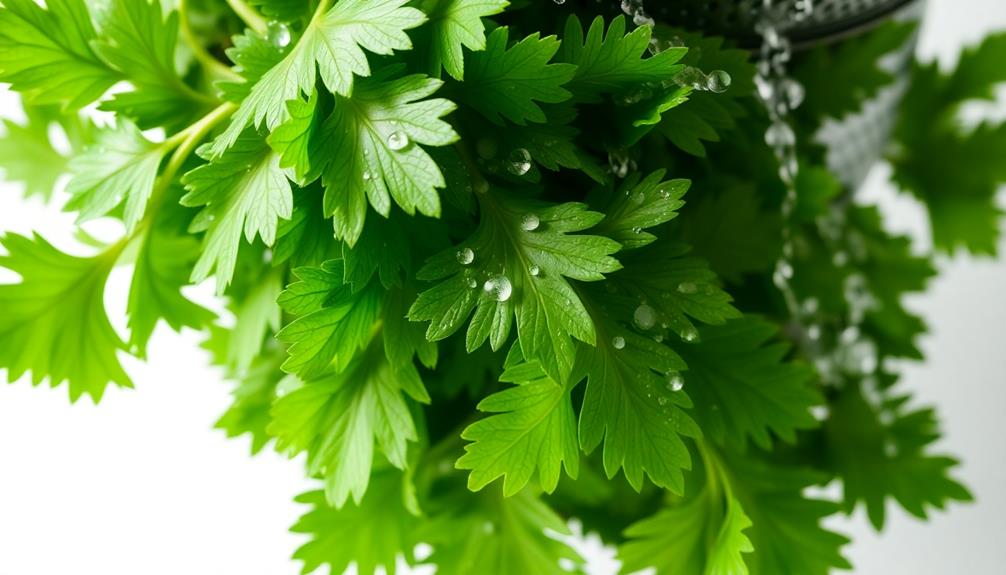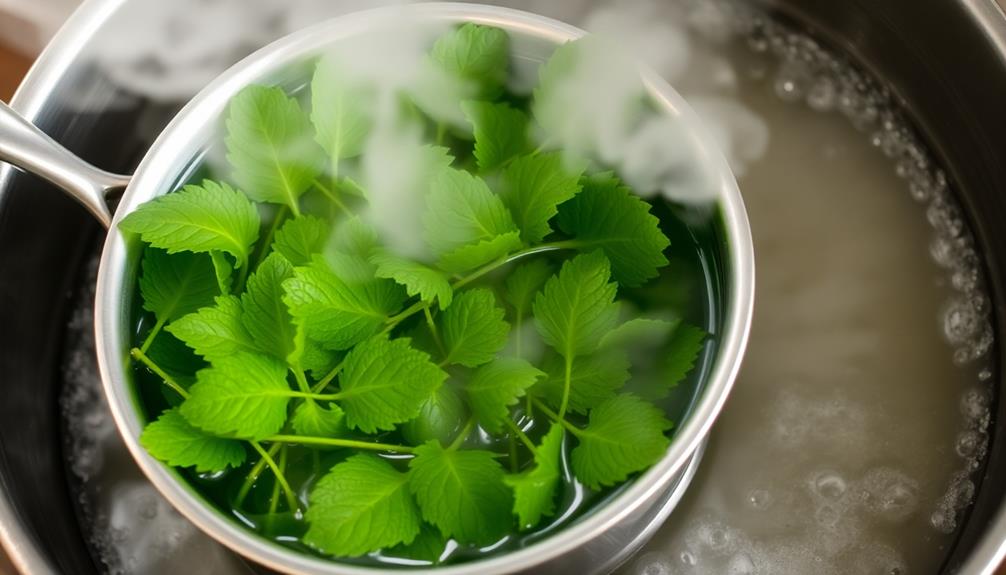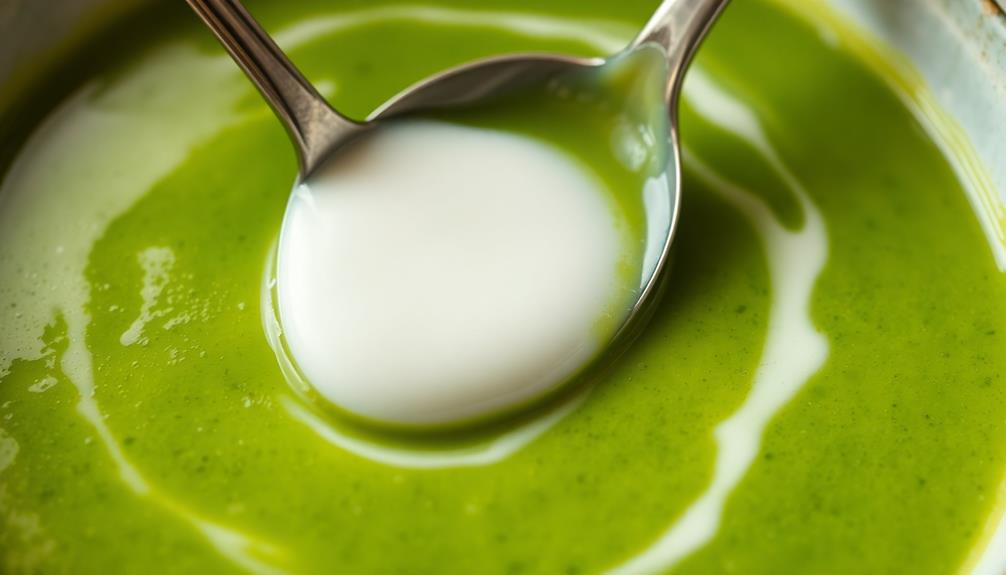Nettle soup celebrates the wild, nutritious greens foraged across continents for centuries. You'll find these vibrant greens packed with vitamins, minerals, and antioxidants – perfect for spring menus. Carefully harvest the leaves, tame their bite through blanching, then simmer in a rich stock for a hearty, earthy flavor. Enhance the creaminess with milk or cream, seasoning to your taste. Garnish with sour cream or yogurt for contrast. Whether locally foraged or market-sourced, nettle soup offers a delightful taste of the season's wild bounty. Discover more about this versatile ingredient and its culinary exploration.
Key Takeaways
- Nettles have been consumed as food across Europe, Asia, and North America for centuries, with a rich cultural and historical significance.
- Nettle soup offers a nutritional bounty, being rich in vitamins, minerals, and antioxidants while low in calories.
- Nettle soup can be made using fresh nettle leaves, stock, cream or milk, and simple seasonings, with careful handling required to avoid stings.
- The cooking process, including blanching and simmering, helps tame the bitterness and sting of nettles, resulting in a uniquely flavored soup.
- Nettle soup celebrates the flavors of spring, encourages foraging and sustainable practices, and offers an opportunity for culinary exploration and creativity.
History
Dating back centuries, the use of nettles in culinary traditions has a rich and diverse history.
You'll find that nettles have been consumed as a food source across Europe, Asia, and North America for hundreds, if not thousands, of years. In ancient Greece, nettles were cultivated and used in a variety of dishes. Roman soldiers even carried nettles with them on campaigns, using them to stimulate circulation and provide a nutritional boost.
Throughout the Middle Ages, nettles remained a common ingredient in European soups and stews. Meanwhile, in traditional Chinese medicine, nettles were prized for their purported medicinal properties. Native American tribes, too, incorporated nettles into their diets, often harvesting and preparing them in unique ways.
Today, the humble nettle persists as a versatile and underappreciated wild edible, with chefs and home cooks rediscovering its culinary potential.
Recipe
Nettle soup is a delightfully earthy and nutritious dish that has been enjoyed for centuries. The vibrant green color and robust flavor of nettles make this soup a true culinary delight. Nettles are a powerhouse of nutrients, packed with vitamins, minerals, and antioxidants, making them a healthy and sustainable ingredient.
Foraging for fresh nettles can be an enjoyable outdoor activity, but be sure to wear gloves to avoid the plant's stinging properties. Once harvested, the nettles undergo a simple transformation, becoming a silky, flavorful soup that's sure to impress.
Ingredients:
- 1 pound fresh nettle leaves, washed and trimmed
- 1 onion, diced
- 2 cloves garlic, minced
- 4 cups vegetable or chicken stock
- 1 cup heavy cream or milk
- Salt and pepper to taste
- Sour cream or yogurt (for serving, optional)
Instructions:
In a large pot, sauté the onion and garlic in a bit of olive oil until translucent. Add the washed and trimmed nettle leaves and sauté for a few minutes until wilted.
Pour in the stock and bring to a boil. Reduce heat and simmer for 15-20 minutes, or until the nettles are very soft. Carefully transfer the soup to a blender and puree until smooth.
Return the soup to the pot, stir in the heavy cream or milk, and season with salt and pepper to taste.
When serving, consider garnishing the soup with a dollop of sour cream or yogurt for a creamy and tangy contrast. Nettle soup is best enjoyed immediately, but leftovers can be stored in the refrigerator for up to 3 days. This soup can also be frozen for longer-term storage.
Cooking Steps
First, you'll need to harvest the nettle leaves carefully, as they can sting if not handled properly.
Once you've gathered the leaves, be sure to wash them thoroughly to remove any dirt or debris.
Next, briefly blanch the leaves in boiling water to tame their bitterness, then add cream and let the flavors simmer until they've blended together nicely.
Step 1. Harvest Nettle Leaves Carefully

Donning a pair of thick gloves, you carefully grasp the tender nettle leaves, mindful of their stinging nature.
These wild plants may look harmless, but the tiny needle-like hairs on their stems and leaves can deliver a painful prick if handled carelessly.
Avoiding direct contact, you gently pinch the top four to six leaves, taking care not to disturb the plant's roots.
Nettles grow in dense clusters, so you can efficiently harvest a large quantity in a short time.
Be sure to collect the leaves before the plant flowers, as the older leaves may become coarse and fibrous.
With your haul secured, you're one step closer to creating a delightful nettle soup, a true celebration of spring's vibrant, nourishing bounty.
Step 2. Wash Nettle Leaves Thoroughly

After carefully harvesting the nettle leaves, you'll want to thoroughly wash them to remove any dirt or debris.
Run the nettle leaves under cool, running water, gently rubbing them between your fingers to dislodge any grit or particles. Avoid letting the leaves soak, as this can cause them to lose their vibrant green color and nutrients.
Once washed, pat the leaves dry with a clean towel or paper towels. It's important to ensure they're completely dry before proceeding to the next step, as any residual moisture can lead to spoilage during cooking.
Damaged or discolored leaves should be discarded, as they may impart undesirable flavors to the final soup.
With your clean, dry nettle leaves, you're now ready to begin preparing the nettle soup. The next step will involve blanching the leaves to help tame their potent sting before incorporating them into the soup base.
Step 3. Blanch Nettle Leaves Briefly

With your clean, dry nettle leaves, it's time to blanch them briefly. This step helps to eliminate any remaining dirt or debris, and it also softens the leaves slightly.
Start by bringing a pot of water to a rapid boil. Gently add the nettle leaves, being careful not to overcrowd the pot. Blanch the leaves for just 30-60 seconds, then immediately remove them with a slotted spoon and transfer them to an ice bath. This quick blanching process helps to preserve the vibrant green color and tender texture of the nettles.
Once the leaves have cooled in the ice bath, drain them thoroughly. Gently squeeze out any excess water, being careful not to bruise or damage the delicate leaves.
Now, your nettles are ready to be incorporated into your soup or used in other recipes. The blanching step ensures your nettles are clean, tender, and flavorful, setting the stage for a delicious nettle-based dish.
Step 4. Add Cream

To create a rich and creamy nettle soup, add a touch of heavy cream. This simple addition will lend a luxurious mouthfeel and balance the earthy, grassy flavors of the nettles.
The soothing aroma of the soup can also enhance the overall experience, similar to how aromatherapy can trigger the release of neurotransmitters that promote relaxation. Start by pouring in about 1/2 cup of cream per 4 cups of nettle broth.
Gently heat the soup, stirring constantly, until the cream is fully incorporated. Avoid letting the soup come to a boil, as this can cause the cream to curdle.
The cream will also lighten the color of the soup, giving it a vibrant green hue. Taste the soup and adjust the seasoning if needed, adding a pinch of salt or a squeeze of lemon to brighten the flavors.
For an extra velvety texture, you can blend a portion of the soup before stirring in the cream. Serve the creamy nettle soup warm, garnished with a swirl of cream, a sprinkle of freshly ground black pepper, or a handful of toasted nuts or seeds.
Step 5. Simmer Until Flavors Blend

Once you have added the cream, gently simmer the nettle soup, stirring occasionally, until the flavors have fully blended, about 10-15 minutes.
This gentle simmering allows the cream to seamlessly integrate with the vibrant, herbal notes of the nettles. The heat will mellow the soup's slight bitterness, creating a smooth, harmonious taste.
Periodically stir the mixture to ensure even cooking and prevent scorching on the bottom of the pot. As the soup simmers, you'll notice the color deepen and the textures meld together.
Keep a close eye, as you don't want to overcook the delicate nettles. After 10-15 minutes, the soup should be ready.
The flavors will be well-incorporated, with the cream adding a silky richness to complement the wild, grassy essence of the nettles.
Now it's time to ladle the soup into bowls and garnish as desired, allowing your guests to savor spring's fleeting, flavorful bounty.
Final Thoughts
Ultimately, nettle soup can be a rewarding and nourishing experience for the adventurous home cook. The earthy, grassy flavors of the nettles pair beautifully with the richness of the stock and the brightness of the lemon.
Don't be deterred by the initial sting of handling the nettles – with proper precautions, you can easily transform these wild greens into a delicious and nutritious soup.
The final step is to taste and adjust the seasoning as needed. Add a splash of vinegar or lemon juice to brighten the flavors, and don't be afraid to experiment with different herbs and spices.
Serve the soup hot, garnished with a swirl of yogurt or a handful of toasted nuts for added texture and flavor. Whether you're foraging for nettles or sourcing them from a local market, this simple yet satisfying soup is a wonderful way to celebrate the flavors of spring. For a heartier meal, consider pairing this nettle soup with a side of crusty bread or a fresh salad. And if you’re looking for more seasonal recipes to enjoy, you might also want to try our heirloom bean stew recipe, which features a vibrant combination of heirloom beans, seasonal vegetables, and aromatic herbs. Both dishes are perfect for embracing the abundance of spring produce and nourishing your body with wholesome, flavorful ingredients.
Embrace the wild and reap the nourishing rewards of nettle soup.
Frequently Asked Questions
Are Nettle Leaves Safe to Consume?
Yes, nettle leaves are generally safe to consume. Just be sure to wear gloves when handling them, as the leaves have tiny stinging hairs that can cause an unpleasant rash. With proper preparation, nettles make a nutritious and flavorful addition to your spring meals.
Can I Use Nettle Leaves Instead of Spinach?
You can certainly use nettle leaves instead of spinach. Nettles have a similar taste and texture, and they're packed with nutrients. Just be sure to properly clean and prepare the nettles before using them in your recipes.
How Do I Identify Wild Nettle Plants?
To identify wild nettle plants, look for leaves that are deep green, oblong-shaped, and have serrated edges. You'll also notice they have tiny stinging hairs that can irritate your skin, so be cautious when handling them.
What Are the Health Benefits of Nettle Soup?
Nettle soup is packed with vitamins and minerals that can boost your immune system, reduce inflammation, and provide a natural energy boost. Its rich, earthy flavor makes it a delightful springtime treat.
Can I Freeze Leftover Nettle Soup?
Yes, you can freeze leftover nettle soup. It'll retain its nutritional value, and you can enjoy it later when you need a quick, healthy meal. Just make sure to store it properly in an airtight container.









